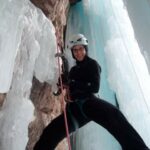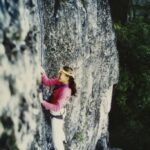Over the last few years, Beth Rodden, arguably one of the best climbers out there, male or female, disappeared from the pages of climbing magazines and blogs. During that time she battled a cycle of injury, surgery, and re-injury, as she attempted to make sense of the sport that debilitated, captivated, and catapulted her. In the last year, after sculpting, chipping, and remolding herself, Beth has emerged as a different kind of climber.

Beth Rodden on the FA of Meltdown, 5.14c (unrepeated). © Corey Rich. www.auroraphotos.com
In her redefinition, Rodden embodies the role of ambassador, designer, story–teller, nutritionist, traveler, and writer. She’s broadened her inspiration from an aesthetic, unclimbed line in Yosemite, to include her granny, a food revolution, and contentment with sending a climb she might have previously warmed up on. Crux Crush was fortunate enough to talk with Beth as she reflects on her personal evolution, as well as the transformation of climbing as a sport. We’ve shared the full interview below as well as some beautiful pictures from the talented Corey Rich. Enjoy and climb on!
Find out more interesting posts here!
CXC: Every climber I know is a huge fan of yours. This is no small feat! Perhaps this is partly because you seem to be modest and private – but this also means we can’t follow your progress via social media very easily. Can you catch people up with your life since Meltdown? It seems you’ve been through a lot of ups and downs, and you’re still climbing and exploring the world (nice NY times article!).
BR: Wow, thank you so much for the extreme compliment, that is super kind. I definitely trend towards a more private “public” life, I think I am naturally more comfortable with a quiet existence. Social media is definitely not my natural way to communicate and express myself, but I see how nice it is for people to follow athletes/artists/etc. I think I did much better in the magazine era, but it’s an interesting way to learn and try to improve. So far I think I’m doing better using Instagram 🙂
I guess it’s been about 5 years since Meltdown, so that’s a bit of time to cover, but I’ll do my best. About a year after Meltdown I tore the labrum in my shoulder. I’d always had shoulder issues, but knew this one was different when it felt like my arm wanted to fall out of socket just standing there. After 6 months of rehab, I was back to about 75% and then severely injured the A1 pulley and lumbrical muscle in my left index finger. After much thinking I thought if I was out for 6 months with my finger, maybe I should get my shoulder fixed.
Unfortunately, that was also the start to several years of injury and re-injuries, something of which I’m still struggling with now. During that whole time I was continuing to try to climb, and wanting to push myself. Unfortunately, I would get too psyched and hurt myself again before I could come back to full strength. One nice thing that has come out of it is that I’ve been able to climb on routes that I’d always heard about but never climbed on before. A lot of the easier, more moderate classics in Yosemite. I also think it really showed me how much climbing means to me.
“After going through a divorce and almost 4 solid years of injuries during that time, I’ve come to appreciate just being able to go climbing at all. Not being able to use climbing as an outlet and escape was quite difficult and in the end made me appreciate going climbing in any capacity so much more. It’s really cemented my love of being outside in the mountains with friends.”
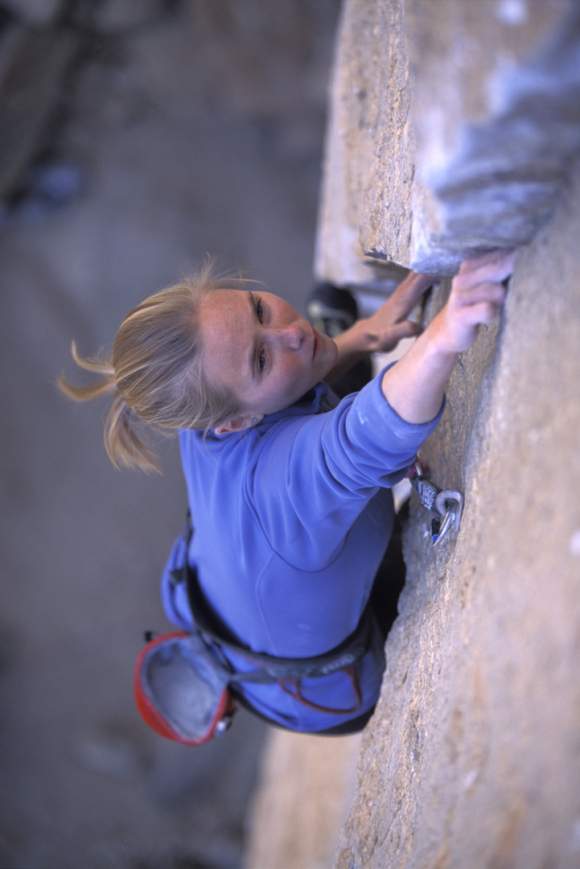
Beth on the FA of The Optimist, 5.14b. © Corey Rich. www.auroraphotos.com
CXC: Free climbing has exhibited a paradigm shift in the last 20 years from a predominantly outdoor, non-organized, non-competitive sport to a largely indoor, often organized, and often competitive sport. As one of the first “kids” to be raised on gym climbing, you dominated competitions and then seemed to pause and reevaluate something before you went back to the roots of the sport.
Some people see that as a shift in the “right direction.” What, internally and/or externally, drove this change? Can you expand on how you’ve seen the sport change (commercialization, gyms, training, grades?), how these pieces all fit together, how you feel about that, and what you’d change if you could?
BR: The sport has definitely been changing with the expansion of the climbing gym business. It seems that there are new gyms going up all the time. And the gyms are getting bigger and better, getting more and more people into the sport. There are about 10 gyms in the bay area and I can’t believe how crowded each gym is, even with other gyms only miles from each other.

Beth on Book of Hate, 5.13d, Yosemite, CA. © Corey Rich. www.auroraphotos.com
The gym is how I started climbing, but the culture in the gyms has definitely changed. When I started in a gym, it was a tiny gym, run by two mountain guys who loved climbing and loved going to the mountains to climb. It had a real “mentorship” feel and role to it. Everyone who worked at the gym was a climber, and everyone who climbed at the gym used the gym for training for outdoor climbing. Now it seems that a lot of people who climb in gyms, use it solely for exercise, which is totally fine, it’s just a shift.
“I wasn’t old enough to drive when I started climbing, so the only way I went outside was with one of these “mentors” who ended up teaching me about climbing outside, ethics, dos and don’ts, etc. Definitely had a “passing down” from generations feel.”
There were no coaches back then, no organized teams, just heading out climbing if you wanted to, training if you wanted to, project if you wanted to, and so on. I think things have become much more organized, as I think anything would with the growth in popularity that climbing has achieved. Whether that’s the “right” way or the “wrong” way, I’m not sure…it’s just a “different” way than how I was raised in climbing. However, with the rise in numbers of climbers from the gyms heading into the mountains without that mentorship phase, I think it is important to pass on certain ethics and leave no trace of concepts to them.
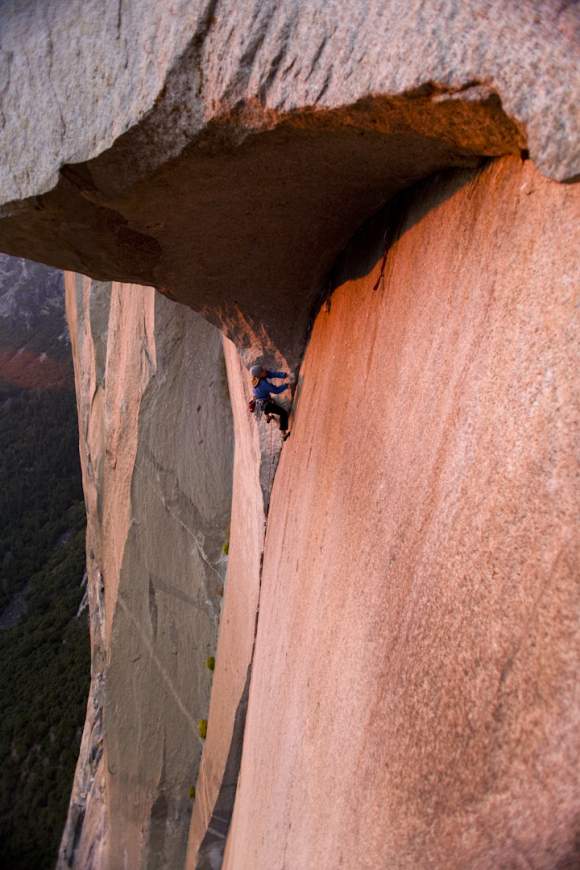
Beth at the Great Roof pitch, 5.13c, on The Nose. © Corey Rich. www.auroraphotos.com
For me, the change away from comps came after I had been primarily competing for 6 years. I grew up competing and most of my friends were competing (Katie, Tommy, Chris, etc) and it was a fun way to be able to get out and see them. I definitely still climbed outside then, during school breaks, but competitions were my main focus. I could tell I was losing steam in the comp realm and the only way to really focus on comps at that time was to move to Europe and compete over there. I was much more psyched to travel and climb and push myself outdoors. Lynn Hill invited me to go on a trip with her, Nancy Feagin and Kath Pyke to Madagascar when I was 18 or 19, and basically that sealed the deal. As soon as I saw this lifestyle as a way to travel and climb all over the world, I was hooked. Not long after that Tommy and I started dating, and the rest is history…
CXC: There’s been some debate about the role of women in pushing the sport (Andrew Bisharat’s article in Rock & Ice) –
he basically made the point that men (because of testosterone) have the drive to seek out hard first ascents and that women aren’t doing this. You are in a very unique position to discuss this, since you’re one of the only women in history to have pushed style and grades beyond what men are doing (i.e. Meltdown, the Optimist). What role do women have at the top levels of climbing? How has the male/female dichotomy influenced your climbing? Are men simply stronger and less risk-averse? Do any of these factors matter to you, when you consider your goals at the highest levels of the sport (both personally, and professionally)?
BR: I think women (or a woman) have/has had a position at the top level of climbing for some time now, ever since Lynn did the Nose. Her ascent was so far ahead of her time it’s crazy. Ten years before Tommy and I went back and repeated it she was able to free the most famous route in the world before any men, and keep that record for a decade. And that’s after most of the strong men in the free climbing world tried and failed to repeat it.
“I know that [Lynn Hill’s] climbing and my two first ascents aren’t the norm for climbing, but it at least shows that it can be done. Why aren’t more women doing it? I’m not sure, but that’s not to say they aren’t capable. I think there are more and more women coming into the sport, so it’s bound to change.”

Beth on El Capitan. © Corey Rich. www.auroraphotos.com
Tommy was by far the most influential person in my climbing, hands down. And for ten years he was basically my sole climbing partner. Before I was with him, I mainly climbed with guys, not because I didn’t want to climb with women, but there just weren’t a lot of women around. When I was a kid in the gym, it was me and the boys. Occasionally I could climb with a woman, but it was very rare. However, over the past five years, I’d say that I climb with women just as often as I climb with guys.
I think that there are just more women in the sport now, and with a bigger population you are bound to find women you click with and are psyched to climb with. I’m not sure I’ve ever thought of it as female versus male influence in my climbing, I think it’s actually more of a personality influence for me. Some people I’m much more psyched to climb with and be around than others.
I guess I haven’t thought a ton about this question, whether men are simply stronger and less risk averse. I think that a lot of the men that are developing the hardest routes and boulder problems are amazing at what they do (Dave, Jonathan, Tommy, Dani, etc). However that’s not to say that women couldn’t do it as well.
Obviously first ascents are very rewarding for factoring in goals. But, for me and my goals I usually pick things that I am excited to work on and put in a lot of effort, because that’s what it usually takes. I might be able to bang my head against a first ascent that is terrible and no fun to climb on at all, but I’d much rather work on a beautiful, striking route that I would be repeating.
I’m probably not the best person to answer this question, but I do think with the popularity in climbing rising, we’ll start to see more females out there pushing the limits. I’m definitely inspired by that, but I’m also inspired by amazing ascents by the guys as well.
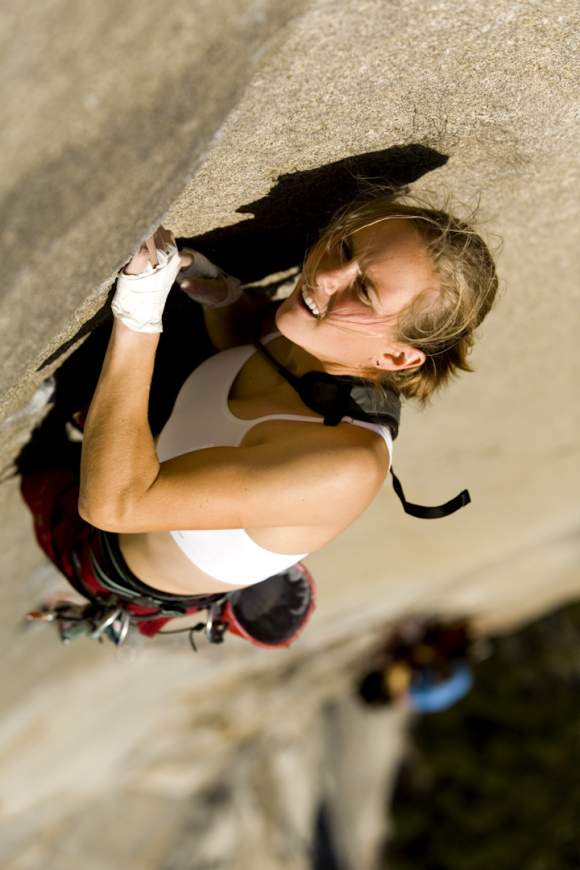
Beth on El Cap. © Corey Rich. www.auroraphotos.com
CXC: The final “question” is more straightforward – what’s the difference between being a climber and being a professional climber? Obviously the pro gets a paycheck and has no/less of a “normal” job.
But being a professional MUST change the simple act of climbing, and, like anything, there must also be a “hustle” to the whole thing. Not to mention the fact that there aren’t NBA size paychecks to retire on at age 40…
BR: Ha, yes there definitely isn’t a retirement package with being a professional climber, but that would be nice! It’s an amazing life. There definitely is a “work” element to it. I get that question a lot at slideshows “how and what do you do as a professional climber? Do you just sit around when you aren’t climbing collecting a paycheck?” And the truth is it’s a myriad of things from climbing, to writing, to clinics, to presentations, to dealer events, to sales meetings, to design meetings and so on.
I think the only time in my professional climbing life that it was just about climbing was the first six months. As you get further and further into it there are more and more layers and things that you do. Which, honestly I actually like and crave. I enjoy the stimulation of learning and doing different things and having other skillsets. Yes, I love climbing and that will always be my passion, but it’s also fun to exercise other creative outlets as well. I definitely can’t climb everyday, so it’s nice to be able to have other avenues to express myself when I’m resting.
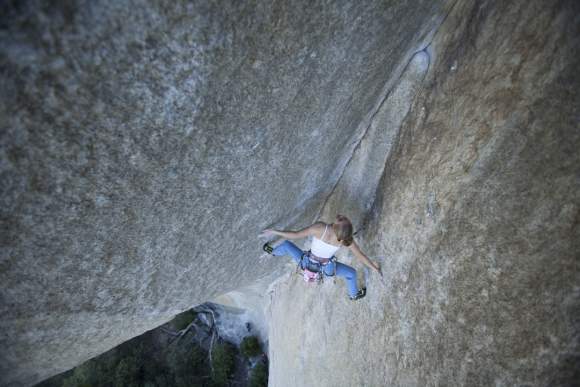
Beth on Book of Hate. © Corey Rich. www.auroraphotos.com
As far as it changing climbing for me, I think that I’ve been doing it for so long now that I don’t really know another way. I do think that at times I’ve gone through phases of being very self conscious at the cliff if I’m not climbing well or sending the hardest thing. But I’m starting to realize that everyone is human and will understand. Yes, there is an underlying knowledge that I do this as my profession, but I’ve also realized over the past few years with injuries that I would climb even if I couldn’t have it as my profession. Even if I can only climb 5.9, I’m going to climb.
“I’m not going to stop if I can’t climb 5.14 or get paid to climb, I’ll still always be climbing. I’m very lucky and grateful that for the past decade or so that I’ve been able to make it my profession, but when 5.14 becomes completely antiquated (which it is starting to already) and I’m not at the top of the sport, you’ll still find me outside, with friends in the mountains climbing, because I love it.”
CXC: Thank you Beth Rodden! We so appreciate your openness, passion, inspiration, and love for the sport.
Beth is supported by the following sponsors:
![]()










